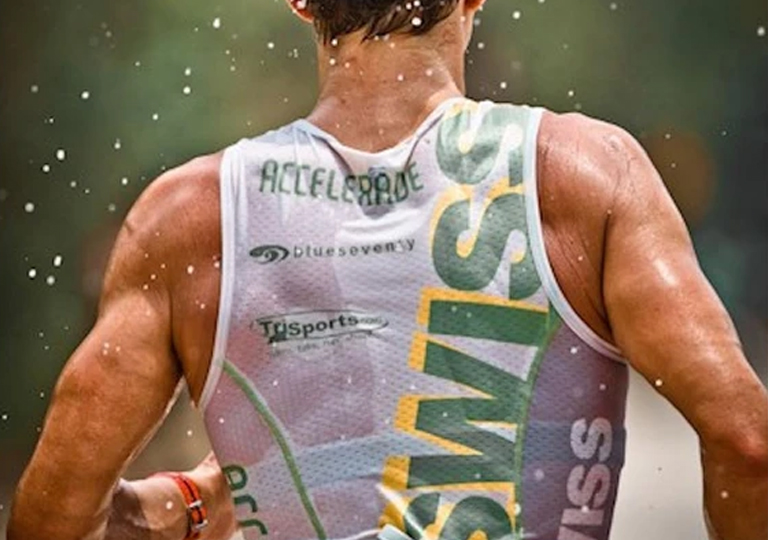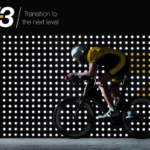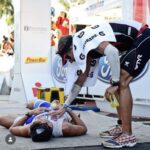Hyponatremia means roughly “low salt levels”, and can be brought on by decreased ingestion of sodium or by increased intake of sodium-free or sodium-low fluids. In effect, hyponatremia is a state in which your body’s electrolytes are too dilute. In extreme cases this can lead to death.
In milder forms, the condition rears its ugly head in the form of swelling of the body as fluids move from the cells into the interstitial fluid in an osmotic effect, nausea, cramping, fatigue in part due to a reduced ability to metabolize carbohydrates, a swollen stomach as fluids remain trapped in the stomach because digestion is interrupted, and so on.
Mild hyponatremia is not a severe condition, but if you are not aware of the causes and effects of hyponatremia the condition can worsen, especially if you consume more and more water to compensate for symptoms that inexperienced athletes can easily misdiagnose as dehydration.
There are plenty of athletes who take extra salt both preceding and during a major race, with Hawaii being the most obvious location where extra salt should be taken in prior to the start.
In one famous instance of a hyponatraemia-induced meltdown, Jan Ripple, another famous member of the Death March Club, in her comments after a mid-80’s Hawaii race she was leading until about mile 20 of the run until she collapsed, made the comment that she didn’t know why she fell apart late in the race–“I drank 12 large bottles of water on the bike . . .”.
In effect, Jan diluted her electrolyte levels by drinking too much sodium-free fluid (water) without compensating by taking in more salt. In especially sever conditions in Lanzarote 1997, Paula Newby-Fraser observed that many athletes pee’d away their minerals and electrolytes by drinking to much in hydrating before the race without consuming extra electrolytes along with the fluids. From my experience in listening to the experts, the evidence is that salt and electrolyte loading prior and during an Ironman is crucial if you want to succeed.
2010 Ironman World Championships in Kona. A very hot & humid day. Windy!! I bonked on the bike (mile 70) but still finished 25th Pro in 8h42min. Racing in kona is always really hard and it hardly ever goes according to plan.
Extra salt helps–a lot. Especially during training when you are lacking sleep.
Have you ever found that your body tends to swell up?–water seems to be retained in the interstitial fluid instead of in the cells. Extra salt helps restore the balance and encourages the body to eliminate the extra fluids–which runs contrary to what one would think. Truth is, if the body is lacking salt, you will swell up like a balloon as water moves out of your cells and into your interstitial fluid.
If you are sweating copiously such as in a race like Hawaii (or Brazil, Lanzarote, Malaysia, etc.), it takes TWO LITRES of Gatorade per hour to replace the salt you are losing. About 1/2 a TABLESPOON of salt is lost PER HOUR! Think about that. That’s more than the average DAILY suggested consumption. Per hour. For at least 8 – 9 hours (if you include a warm swim!), and many more for later finishers.
Since you aren’t going to absorb every bit of salt that you consume, I think this amount of salt (and consequently the volume of Gatorade) that you need to consume is in fact too low. You need more than what’s lost to be able to replenish your electrolytes, because inevitably you will metabolize some during absorption, and due to inefficiencies some will not even be absorbed.
There is a catch, however, and that is: you can absorb only up to about 800mL per hour of fluid per hour–and that’s if you’re a big person–meaning that there’s no way you can get even 1/2 the salt that you lose per hour (on a hot, long day) from drinking Gatorade electrolyte drink alone. You should not try to drink 2L of Gatorade per hour–one, you can’t absorb that much fluid, and two, you can’t grab and drink that much in one hour any way, not if you’re going hard. So you need to look elsewhere for another source of salt than just an electrolyte drink, especially if it’s a dilute electrolyte source or if the drinks have been improperly mixed and are too dilute.
Further complicating matters is the anti-salt health kick that was/is promoted so heavily in the past few years. Many people think that salt, per se, is unhealthy. This simply is not true–too much salt is unhealthy. However, the 1 teaspoon per day of salt that is recommended as a healthy amount to a couch potato! But, seriously, how much do couch potatoes sweat? Not a lot!!
An athlete in hard training needs more salt than the average person–in my view a lot more, such as double or triple the suggested amount (depending on how hard you’re training). In fact, if you are riding one of your long pre-Ironman bricks on an especially hot Saturday, you’ll be simulating race day conditions and you will need to consume extra salt to make up for what you lose in sweat (and blood and tears if it’s a tough day!).
For this reason I think electrolyte supplementation on your hard training days is important for Ironman athletes.
For these reasons I always suggest taking in extra salt in hard training for, just prior to, and during an Ironman.



